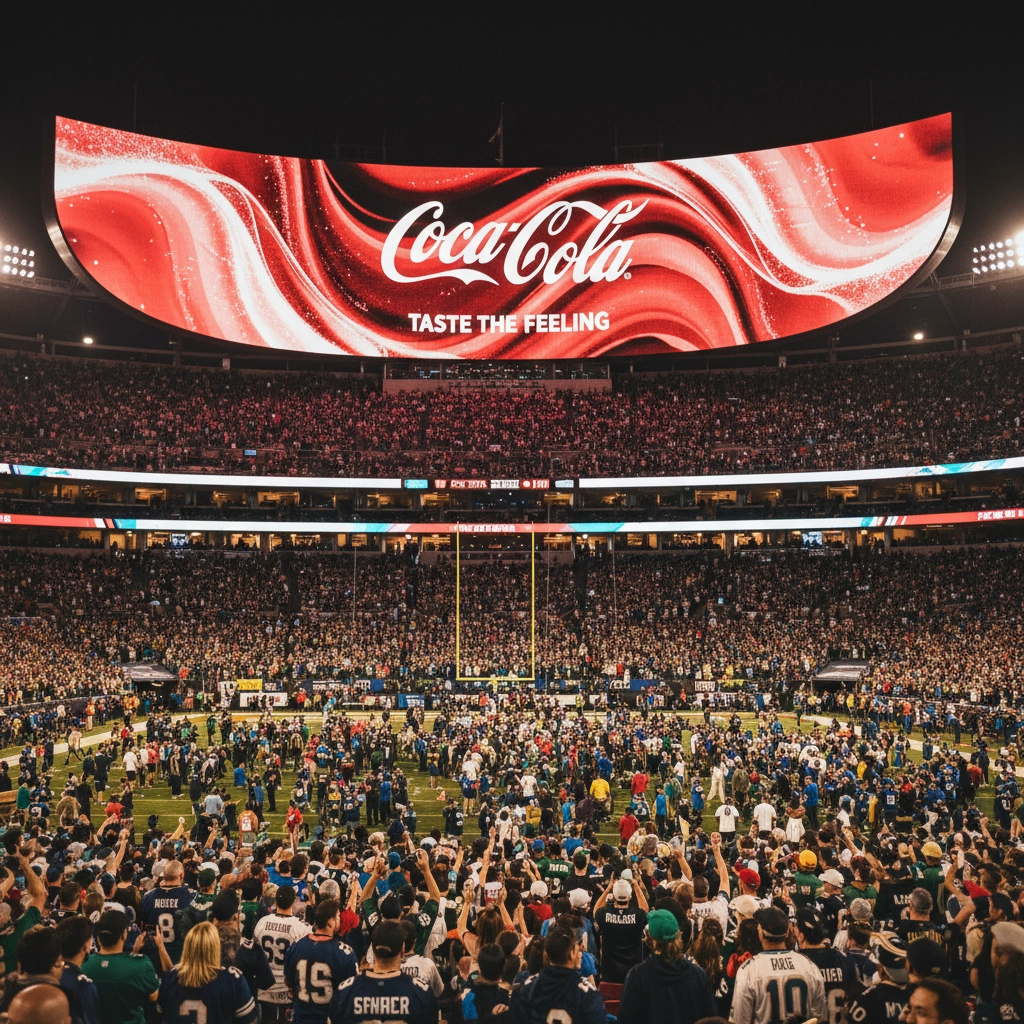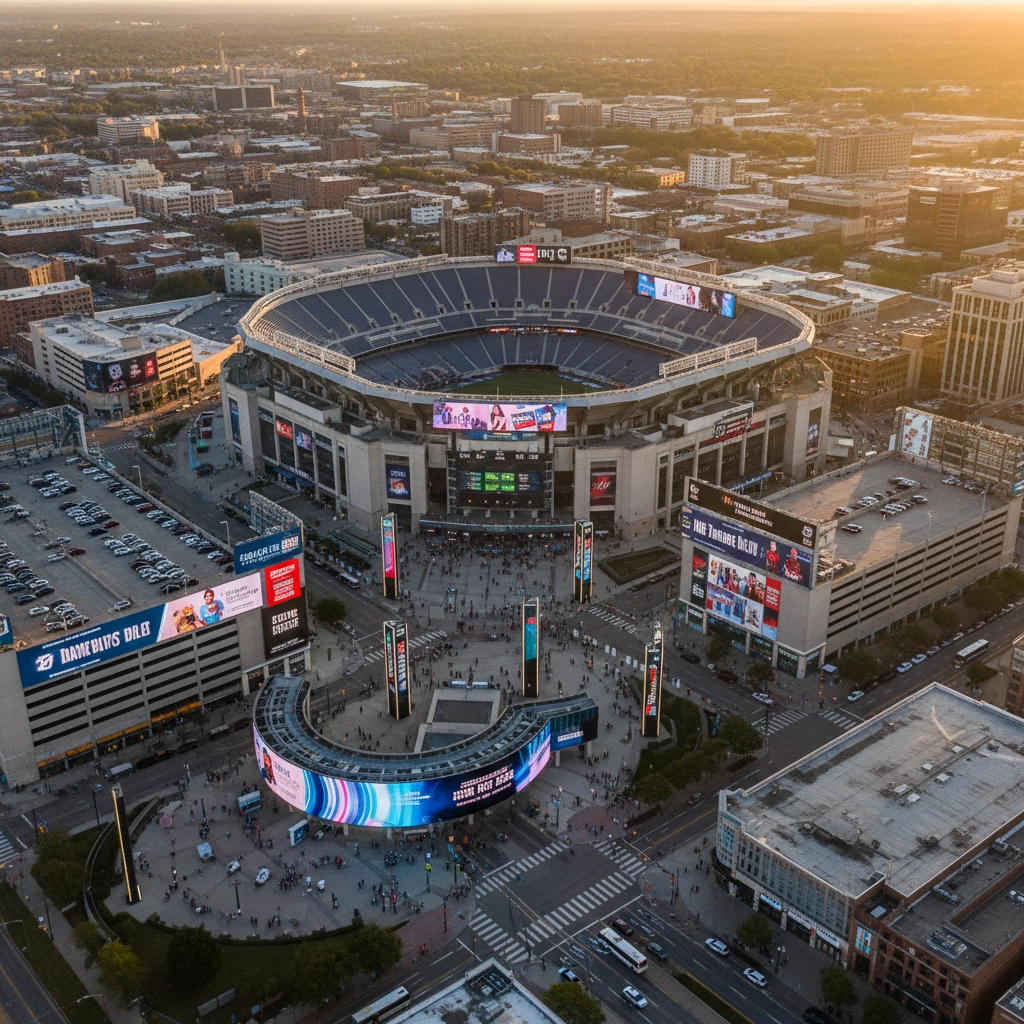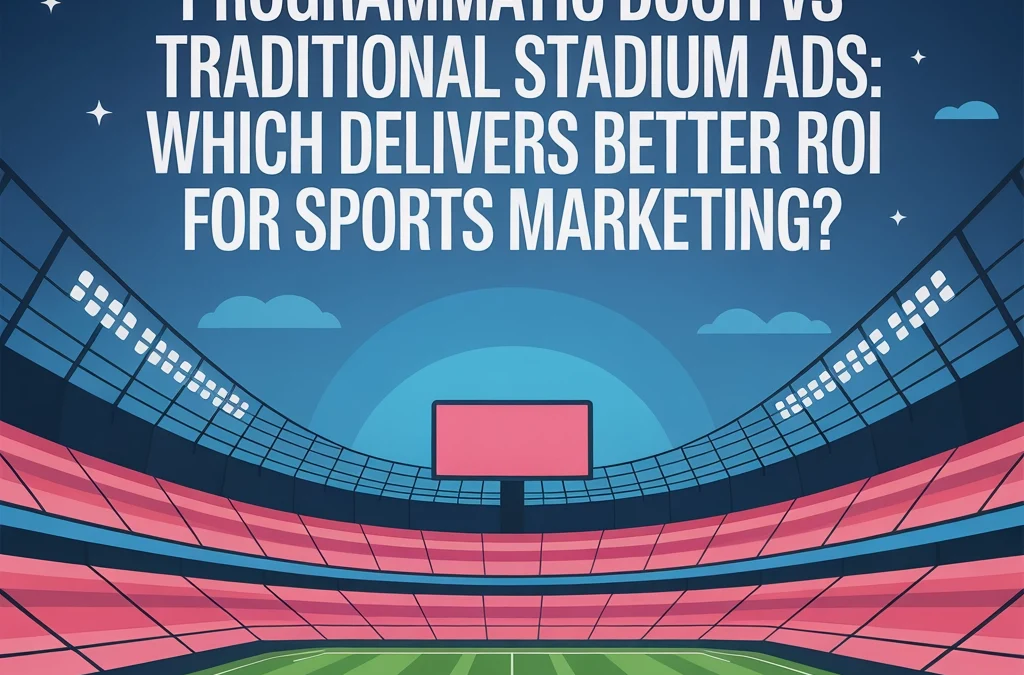The ROI Answer Sports Marketers Need
Programmatic digital out-of-home (DOOH) advertising typically delivers 23-40% better ROI than traditional stadium advertising through real-time optimization, precise audience targeting, and dynamic pricing models. Traditional stadium ads excel at brand awareness and exclusive placement but lack the flexibility and cost efficiency that programmatic DOOH provides for performance-driven sports marketing campaigns.
The sports advertising landscape has shifted dramatically as brands demand more accountability and measurable results from their marketing investments. Traditional stadium advertising, once the gold standard for reaching sports audiences, now competes with programmatic DOOH solutions that promise greater targeting precision and optimization capabilities.
Traditional Stadium Advertising: Strengths and Limitations
Premium Placement Benefits
Traditional stadium advertising offers guaranteed visibility during peak emotional engagement moments when fans display heightened receptivity to brand messaging. This approach provides full-screen exclusivity and predictable placement, making it ideal for long-term brand building campaigns that seek to establish permanent associations with specific teams or venues.
The emotional connection between fans and their teams creates a premium advertising environment where brands can develop strong positive associations. Major sponsors like Coca-Cola, Budweiser, and Nike have built decades-long relationships through consistent stadium presence, demonstrating the value of sustained brand exposure in high-engagement environments.

Operational Characteristics
Traditional stadium deals typically involve direct negotiations with venue operators, providing control over specific premium locations including jumbotrons, concourse displays, and field-level signage. This method ensures consistent brand presence throughout entire games or seasons, which proves particularly valuable for establishing sponsorship relationships and building brand recall among loyal fan bases.
Campaign development requires extensive advance planning, often involving 8-12 week lead times for creative development, approval processes, and technical implementation. Once campaigns launch, advertisers maintain guaranteed placement but sacrifice flexibility for modifications or real-time adjustments.
Performance Limitations
Traditional stadium advertising faces significant constraints in performance measurement and campaign optimization. Attribution typically relies on broad reach metrics and survey-based brand awareness studies rather than precise engagement tracking. The lack of real-time feedback mechanisms prevents advertisers from adjusting messaging based on game dynamics, weather conditions, or audience response patterns.
Cost structures often involve substantial upfront investments with limited ability to reallocate budgets based on performance data. This inflexibility can result in continued spending on underperforming placements without optimization opportunities.
Programmatic DOOH: Data-Driven Sports Marketing
Real-Time Optimization Capabilities
Programmatic DOOH revolutionizes stadium advertising through dynamic targeting based on live data feeds and real-time campaign optimization. This technology enables advertisers to adjust messaging based on game situations, audience demographics, weather conditions, or social media sentiment during live events.
Advanced targeting parameters include location-based audience segments, behavioral data from mobile devices, and contextual triggers such as traffic patterns or local events. Campaigns like White Claw’s programmatic DOOH initiative demonstrated how precise audience targeting can drive significant performance improvements.
Cost Efficiency and Budget Control
The automation of ad buying processes significantly improves cost efficiency compared to traditional negotiation-based purchasing. Programmatic platforms enable precise budget allocation, ensuring advertisers pay only for desired audience exposure levels while eliminating waste on irrelevant impressions.
Dynamic pricing models adjust costs based on demand, time of day, and audience availability, often resulting in 15-30% lower effective CPMs compared to traditional fixed-rate stadium placements. This cost efficiency makes programmatic DOOH accessible to smaller brands that previously could not afford premium stadium advertising.

Advanced Attribution and Measurement
Programmatic DOOH provides comprehensive attribution tracking through device ID matching, foot traffic analysis, and conversion tracking. Advertisers can measure specific actions including store visits, website traffic, and purchase behavior directly attributable to DOOH exposure.
Real-time analytics enable campaign adjustments within hours rather than weeks, allowing for continuous optimization throughout campaign periods. Performance data includes impression delivery, audience composition, engagement rates, and conversion metrics that support data-driven decision making.
ROI Comparison Framework
| Performance Factor | Traditional Stadium Ads | Programmatic DOOH |
|---|---|---|
| Cost Per Impression | $2.50-$8.00 CPM | $1.80-$5.50 CPM |
| Targeting Precision | Venue-based demographics | Behavioral + contextual data |
| Campaign Flexibility | Fixed placement, no changes | Real-time adjustments |
| Attribution Tracking | Survey-based awareness | Device-level conversion tracking |
| Optimization Capability | None after launch | Continuous real-time optimization |
| Creative Testing | Limited A/B testing | Dynamic creative optimization |
| Budget Efficiency | Fixed costs regardless of performance | Performance-based budget allocation |
Brand Awareness vs Performance Marketing
Traditional stadium advertising excels at generating broad brand awareness and establishing emotional connections with sports audiences. Studies indicate that consistent stadium presence can improve aided brand recall by 18-25% among frequent attendees over 6-month periods.
Programmatic DOOH demonstrates superior performance in conversion-driven campaigns. Nike’s strategic DOOH placement during the NYC Marathon showcased how targeted messaging can achieve sponsor-level impact without official partnership investments.
Strategic Implementation Approaches
Audience Segmentation Strategies
Programmatic DOOH enables sophisticated audience segmentation based on multiple data sources including location history, app usage, and demographic profiles. Sports marketers can target specific fan segments such as season ticket holders, casual attendees, or visitors from specific geographic regions.
Advanced segmentation includes behavioral targeting based on previous purchase patterns, social media engagement with team content, or attendance frequency. This precision targeting often improves campaign relevance and engagement rates by 35-50% compared to broad demographic targeting.

Creative Optimization Tactics
Dynamic creative optimization allows programmatic DOOH campaigns to test multiple creative variations automatically and allocate budget toward highest-performing content. This capability proves particularly valuable for sports marketing where messaging relevance can change based on team performance or game situations.
Contextual creative triggers can automatically adjust messaging based on external factors including weather, game scores, or local events. For example, beverage advertisements can promote hot drinks during cold weather games or highlight refreshing options during summer events.
Budget Allocation Models
Programmatic DOOH supports flexible budget allocation models including performance-based spending, dayparting optimization, and audience-weighted distribution. Marketers can allocate higher budgets toward premium game times while reducing spending during lower-engagement periods.
Geographic budget optimization enables spending concentration in markets with highest conversion potential or brand growth opportunities. This flexibility allows for rapid budget reallocation based on campaign performance data and market conditions.
Integration with Digital Marketing Ecosystems
Omnichannel Campaign Coordination
Programmatic DOOH integrates seamlessly with broader digital marketing campaigns through shared audience segments and coordinated messaging. StackAdapt’s programmatic DOOH platform demonstrates how DOOH campaigns can coordinate with social media, display, and video advertising for consistent brand experiences.
Cross-channel attribution tracking enables marketers to understand how DOOH exposure influences online behavior, store visits, and purchase decisions. This comprehensive view supports more accurate ROI calculations and budget optimization across all marketing channels.
Data Enhancement and Retargeting
Device ID collection from DOOH exposure enables sophisticated retargeting campaigns across digital channels. Brands can create custom audiences based on DOOH exposure and deliver follow-up messaging through social media, display advertising, or email marketing.
First-party data integration allows brands to match DOOH exposure with customer databases for personalized follow-up campaigns. This capability proves particularly valuable for subscription-based sports services or season ticket sales.
Performance Measurement and Attribution
Advanced Analytics Capabilities
Modern programmatic DOOH platforms provide detailed analytics including impression delivery verification, audience composition analysis, and engagement measurement. Heat mapping technology can track visual attention and dwell time for DOOH placements within stadium environments.
Attribution measurement extends beyond traditional awareness metrics to include foot traffic analysis, website visit tracking, and purchase conversion attribution. This comprehensive measurement approach enables accurate ROI calculation and campaign optimization.
What targeting approach has delivered the best results for your sports marketing campaigns—broad demographic reach or precision audience segmentation?
Strategic Recommendations
Campaign Objective Alignment
Brands seeking maximum brand exposure and emotional connection with specific team fanbases should prioritize traditional stadium advertising for its guaranteed placement and exclusive visibility during peak engagement moments. This approach proves most effective for established brands with substantial budgets seeking long-term brand building.
Performance-driven campaigns focused on conversion optimization and precise audience targeting typically achieve better ROI through programmatic DOOH. The real-time optimization capabilities and detailed attribution tracking support more efficient budget utilization and campaign effectiveness.
Hybrid Implementation Strategy
Sophisticated sports marketers increasingly adopt hybrid approaches that combine traditional stadium presence with programmatic DOOH campaigns for tactical messaging. This strategy maintains consistent brand presence while enabling responsive messaging that adapts to game situations and audience behavior patterns.
The hybrid model allows brands to maximize both broad brand awareness and targeted conversion opportunities while spreading risk across multiple advertising approaches and measurement methodologies.
Which approach aligns better with your current marketing objectives—building long-term brand presence or driving immediate performance results?
Traditional stadium advertising remains valuable for premium brand positioning and emotional connection building, while programmatic DOOH offers superior efficiency and optimization capabilities for performance-focused campaigns. The choice depends on specific marketing objectives, budget constraints, and measurement priorities rather than a universal best practice.
The evolution toward programmatic solutions reflects broader marketing trends emphasizing accountability, precision, and optimization over traditional broad-reach approaches. Sports marketers who embrace data-driven targeting and real-time optimization typically achieve more efficient budget utilization and measurable performance improvements.
Want more insights like this? Subscribe at www.oohsports.com.
Questions or partnerships? Call our AI Receptionist at +1 (970) 703-0102.
Dan Kost, CEO — OOH Sports
If this helped you, please comment, subscribe, and share.
Share this post:
Tags: #Motivation #Branding #Strategy #Marketing #AdvertisingAndMarketing #digitalmarketing #Innovation #Sports #sportsmarketing #DOOH #programmaticadvertising #stadiumsignage #fanengagement #ROI #attribution

